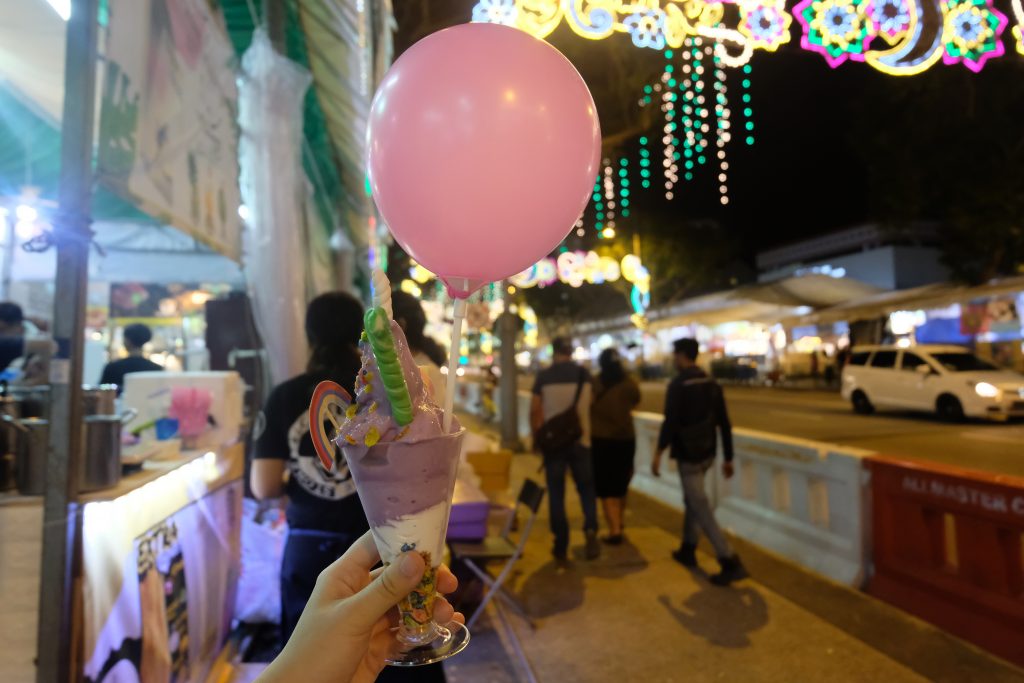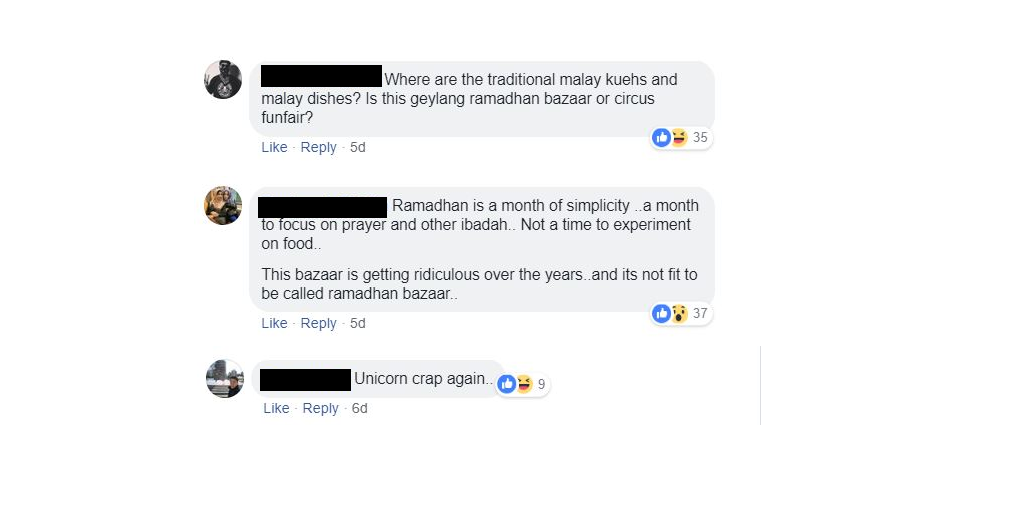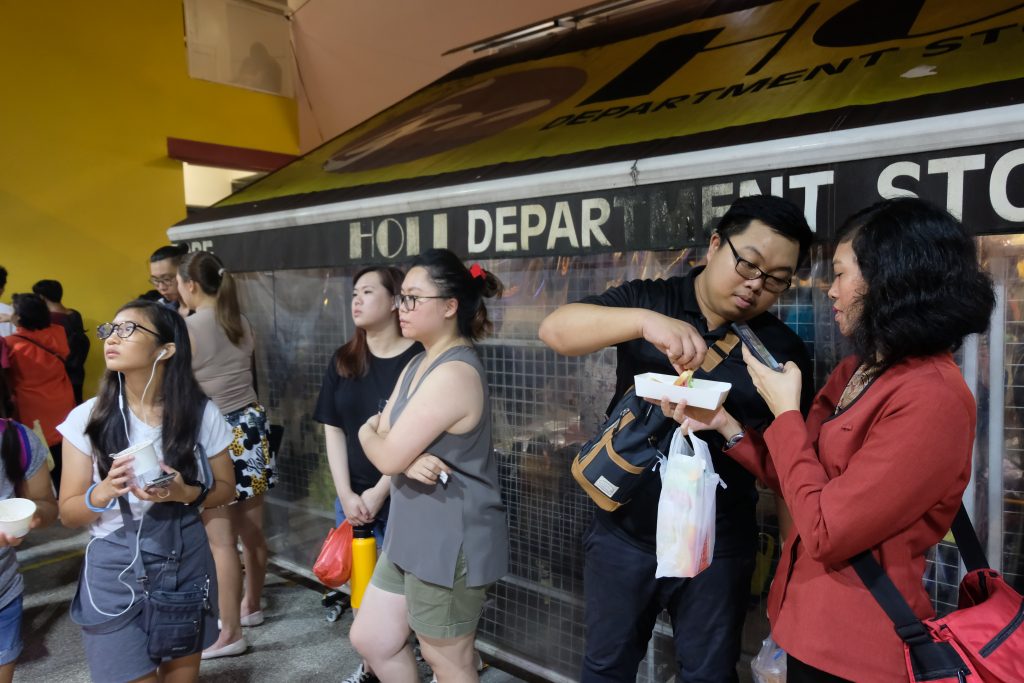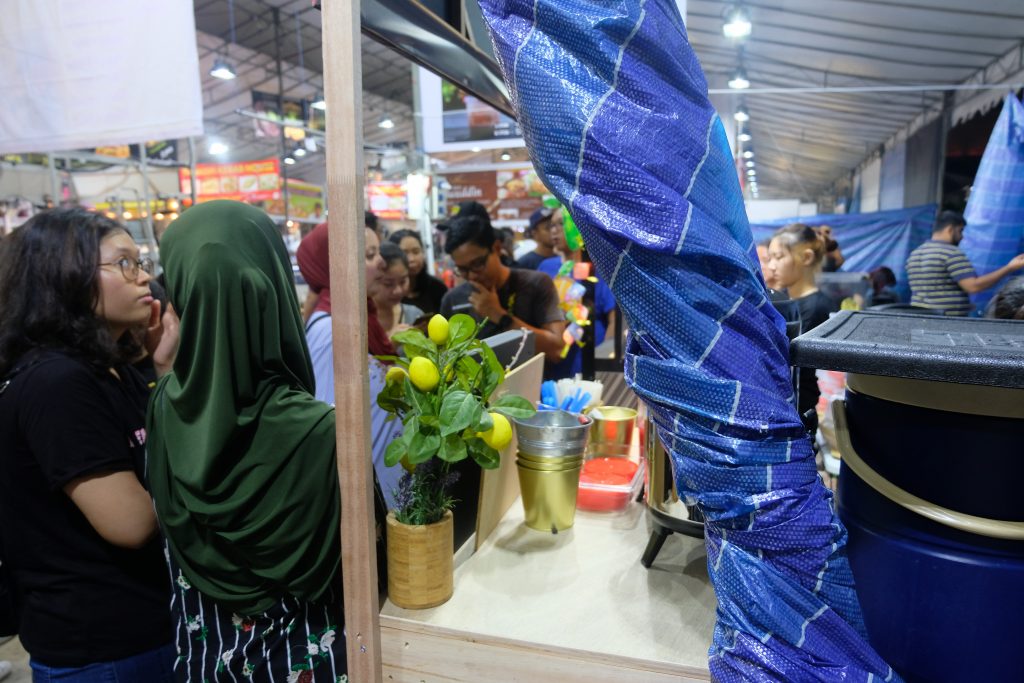To understand 2018’s biggest food controversy thus far, I went to the Geylang Serai Bazaar and ate the following items:
1. 4-colour Cheese Toast (mozzarella with dye)
2. Meatballs and Mashed Potatoes in a Bucket (The type of bucket perfect for making sandcastles)
3. Rainbow Ice Cream Taco (garnished with Rainbow Marshmallows)
But the clear winner for Most Outlandish Food 2018 was no doubt the Flaming Unicorn – a rainbow soft serve topped with hard candy, marshmallows, fruity pebbles, a rainbow flag and a non-edible pink balloon, set ablaze for the customer’s viewing pleasure.
I was suitably appalled. Not just by its taste (100% sugar) and price (an eye-watering $9.90), but also because I have to specify ‘non-edible balloon’ for the sake of clarity. ‘
Edible balloons were also available, at $8.90 a pop.
Photographing this towering hipster ziggurat was a struggle that lasted 2 sticky, gooey minutes. The same amount of time needed to actually eat the confection. By the end, we left feeling angry, cheated and slightly ashamed at ourselves for funding war crimes against dessert.
This is not food. What are we even doing? What a waste of time and money.

Judging by the online response to this year’s Hari Raya Bazaar, we are not alone.
Every comment section is a veritable whirlpool of disgust and outrage that the Ramadan Bazaar should be thus invaded by hipster foods that barely resemble food.

However, this fire-hose of criticism/abuse has stemmed the rainbow tide not one bit. No less than half the stalls were selling ‘trendy’ hipster foods and they were visibly more popular than the regular alternatives. There were long,winding queues for ‘featured’ stalls and every pathway was clogged with people taking photos for the ‘gram.
Outside the cheese toast stall, I counted no less than three insta-boyfriends pulling stringy cheese and holding it in mid-air.

Which begs the question: How? How do we reconcile the paradox of online hatred and brisk business? Why does rainbow food continue to exist every year despite the near-universal disdain towards it?
One common argument goes something like this: Rent is expensive and getting costlier every year. Vendors are forced to sell expensive novelty foods if they wish to turn a profit.
This argument makes about as much sense as sticking a balloon in ice cream and lighting that shit on fire. Demand precedes supply, not vice versa. If no one is being forced to buy unicorn beverages, then no one is being ‘forced’ to sell them.
Hipster Food can only become the answer to rising rental costs if there is a genuine demand for it. They command higher profit margins because consumers are willing and able to pay. Their commercial success might have caused the rent to skyrocket, but rent inflation certainly did not create a demand where none existed beforehand.
Another theory points the finger at non-Malay visitors, who have taken a shine to the bazaar in recent years and thus fuelled the rise of non-Ramadan foods.
This theory is more probable, but it still does not explain the colourful status quo entirely Although the bazaar has attracted more diverse visitors of late, they did not reshape the culinary landscape alone. A fact you can observe by the lack of segregation in the rainbow/hipster bandwagon.
Some hipster vendors are Malay, some are not and some stalls are a striking portrait of racial harmony. The same goes for the queue-happy customers – a multiracial mix if ever I’ve seen one – united only by their saint-like patience in the queue and a love of Instagram.

The truth of the matter is this: Like everything else in Singapore, Pasar Malams obey free market forces. Rainbow shit exists because people buy it.
For every online comment lamenting its existence, there are probably 2 or 3 others quietly tagging their friends; extending unspoken invitations to ‘go try’.
It’s a sentiment that purists may loathe, but absolutely consistent with our national obsession for foods that are absurd, theatrical and gimmicky. If you need an example, just look at 2017: LiHo’s mediocre-ass cheese tea attracted ridiculous queues, as did the Nasi Lemak Burger, the Gudetama Cafe, KFC’s stupid chizza, black-coloured charcoal foods and Bubble tea with fruit floating about.
The list goes on, but you get my point. Rainbow foods may be an atrocity to your taste buds (and wallet), but it is a very Singaporean atrocity.
This is because we look to food not merely for sustenance but also as a social ritual. Relationships/communities are built around sharing food, discussing food, posting food porn and complaining that standards have dropped at X or Y. Whether you love or hate the Mcdonald’s chocolate pie, missing out is never an option because you want to relate, connect and be part of the conversation.
A Rainbow Bazaar is the natural endpoint of such attitudes towards eating. It is what happens when we expect our food to be a social event, an Instagram attraction and a destination experience all rolled into one.
There is nothing wrong with such expectations. Humans have always projected their intangible desires onto food, whether in the form of a wedding cake or a table of status-affirming shark fin soup.
But the problem arises when we expect all this from a bazaar, where the equipment is simple, speed is paramount and prices must be kept low. Under such circumstances, is it any wonder that we are inundated with rainbows? They are the natural outcome of trying to fulfil our culinary wet dreams and social media ambitions without the benefit of an oven.
In other words, this is what happens when you try to create a culinary spectacle for cheap.
The end result is, of course, a technicolour disappointment and, consequently, nostalgia for the ‘good old days’. Understandable but impossible. Instagram and money have long since corrupted our cultural attitudes towards food. It is no longer merely ‘food’ but an expression of status, lifestyle, aspirations and more.
So don’t blame the rent or the hipsters for corrupting food with pointless colours. If you’re looking for a scapegoat, it’s staring right back at us in the mirror.
Have something to say? Write to us at community@ricemedia.co.






